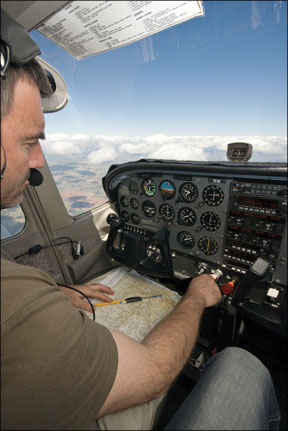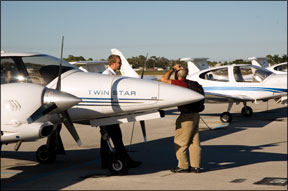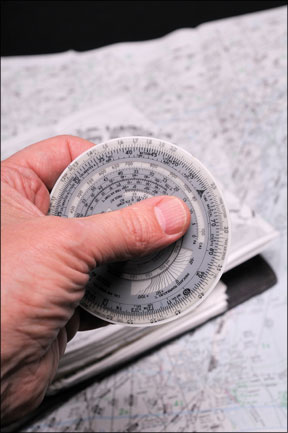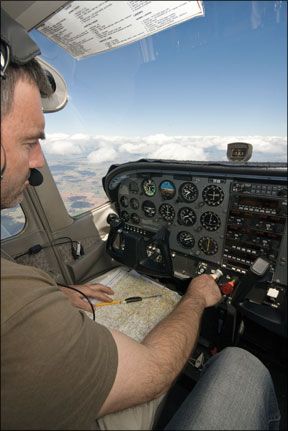Flight time and experience requirements are dropping nearly everywhere pilots are being hired. Some airlines will now hire pilots and put them in the right seat of a jet with no more than a commercial multi-engine ticket and the couple hundred hours required to get it. Critics think this will cause airplanes to fall out of the sky. Others claim improved training and rigorous attention to procedures makes the difference. Lets take a look at both sides of that debate, and see what lessons we can learn from that to improve our own flying. Skill? Or Experience? 288 Theres no argument that experience builds skill and with that experience, hopefully, good judgment follows. Judgment can be taught to some extent, but as the saying goes, there is no substitute for experience. Were reminded of one instructor we knew who tried to pass along the lessons learned from his own experience. But he was quick to point out that he was just one person and with an infinite number of possible mistakes, hed only made half a lifetime of his own, so its important to have the judgment to avoid as many as possible and the skill to survive the rest. Lets define some terms. Well call “skill” the ability to properly and safely operate the aircraft. We might think of “judgment” as the ability to analyze a situation and make the right choice for a safe and comfortable outcome. “Experience” can be thought of as a combination of both skill and judgment. Its been said that experience is what you get when you dont get what you wanted to get, and John and Martha King are fond of pointing out that good judgment comes from experience and experience comes from bad judgment. But well simply define experience as hours in the logbook, each one hopefully building skill and improving judgment. The FAA establishes minimum experience and skill levels for each license. It asks you to demonstrate the requisite skills on a checkride scripted according to a carefully defined set of practical test standards. Getting to demonstrate those skills requires a specified minimum amount of time spent learning them. The idea behind these time requirements is to give you sufficient practice to master the desired skills and allow you to gain a little experience under somewhat controlled circumstances. Judgment There have been various advisory circulars and safety seminars over the years addressing good judgment or, in FAA lingo, “aeronautical decision making.” These typically focus on a systematic evaluation of a situation assessing skill levels, weather, fuel, aircraft performance, etc., to choose a conservative and safe course of action. They also try to teach us to recognize warning signs and patterns of poor judgment. Theres probably not an airline, corporate, military or charter captain alive (or even a flight instructor, for that matter) who hasnt complained about the poor performance and lack of experience and judgment of the person in the other seat. However, if theyre honest with themselves, they can all also remember a time when they severely tested the patience and skill of their pilot in command. Its that ol experience thing again, and you learn to do things well and correctly by making mistakes-lots of em. Somehow, most of us survive it all, and the persistent ones of us actually grow to the point where the mistakes we make are usually smaller and further apart. Those are fine sentiments, but the overall experience level of the typical co-pilot is dropping and the complaints of the veterans are somewhat justified. But, the primary concern isnt their experience and level of mistakes. Its their level of safety. In spite of the complaints from the graybeards in the left seat, the reality is that the level of safety is quite good. So, the primary question then must focus on how they achieve that level of safety with so little experience. Lets take a look. Where Did You Train? Many aviators got their experience through the local FBO or flying club. Although there are some extraordinarily dedicated excellent instructors out there, the little-bit-at-a-time approach most common at FBOs and clubs is typically the least efficient and frequently the least effective way to learn. We personally know of one otherwise competent individual who required nearly 200 hours to get a private license and went through 10 instructors at five different facilities in the process. Although this learning process can seem convenient, its not very efficient and-dare we say it?-due to lapses in the process or outright gaps in the less disciplined programs often may not produce pilots as capable as they could be. 288 At the other end of the spectrum are dedicated flight training academies. These include specialized flight training facilities, community and four-year colleges. These formal flight schools typically operate under Part 141 of the regulations. The FAA has long recognized the efficiencies of a highly structured course of study, and allows pilots in Part 141 schools to get their licenses with less minimum experience. There are two major features of these programs that serve to make them more efficient: structure and immersion. Everything about these flight schools is highly structured. First, the curriculum is very carefully laid out with little opportunity for variations. Sometimes, even the individual lesson plans are specified and dictate each step the student must perform on the way to mastering a particular skill. In addition to the highly structured curriculum, these programs often focus very heavily on disciplined procedures and cockpit workflows to make the learning itself more structured and the results more repeatable. We hasten to point out here that the better FBOs and clubs also have structured curricula that compares very favorably with those at the specialized academies, although they may not focus as much on the disciplined procedures and cockpit workflows. The primary difference in the programs, though, is the immersion of the student. Most of us attained our licenses as working adults. With pressures of job, family, finances and personal lives, there is little time left to focus on an ambitious endeavor like learning to fly. Thus, most often the learning is done in ones spare time. While we might find time to attend a scheduled ground school class at the local flight school or community college, all the flight training time must usually be “stolen” from other activities. The result is that we might have a couple of lessons in one week and be unable to schedule another until weeks or even months later. Add weather, maintenance and competition with others for the instructor and airplanes, and its a wonder that we fly at all. Its not uncommon to achieve a one-step-forward-and-two-back kind of progress where we spend much of the next lesson relearning what we should have retained from the last, but didnt because it was too long ago. To avoid this we need continuity. Continuity and other benefits come from immersion. Total immersion in studies is likely the most effective and most efficient way to learn. Youre surrounded by students with the same interests, and you spend most of your day talking about, reading about, studying and practicing the requisite knowledge and skills. Youre free from other distractions and you have a single focus. Many flight academies have programs that provide this kind of immersion. Your flight training schedule is highly organized with as many as five or more flights a week. Unless your program is part of a larger curriculum at schools that offer 288 degrees, you can usually achieve a private license in one to two months, and most other licenses and ratings in as little as a few days to a couple of weeks once you meet the minimum hours. These immersion programs work well and, one might argue, can save money in the long run because of their efficiency in spite of their higher per-hour costs. Attention to Detail Okay, but what if you simply want to be the best GA pilot possible? How should you approach your training? Obviously, if possible, we recommend one of the academies where you can immerse yourself and quickly meet your goals. If youre just adding an instrument rating or a commercial license, you can probably do this with vacation time. But what if you cant attend one of these schools or if your goals require longer than you can afford to be away, and the only practical way you can proceed is with the local FBO in your spare time? For the knowledge portion, we recommend that you attend a scheduled ground school. Yes, this can take longer than the various self-study programs, but youll likely learn more from the instructor and from working in study groups with fellow students. Consider using one of the many excellent self-study programs as a supplement. Note above that we pointed out the best traits of the dedicated academies are the structure and immersion. We also mentioned the disciplined procedures and cockpit workflows that are a part of these programs. While the structure and immersion of the program help you learn, the attention to detail in the procedures and cockpit workflows are some of the most important things they teach. Clearly its possible to learn at the local FBO or club, but the best results will be obtained through a structured curriculum with regularly and frequently scheduled lessons that teaches procedures and flows. You may have to work with your instructor to tailor a program in this fashion, but we think your results will be better as a result. If your instructor has an airline or military background, this will be second nature. But its also possible that your instructor has never had the benefit of such a structured program and you might have to create it together or go elsewhere. What Will The NTSB Say? But all of this only addresses the skill portion of the learning process. What about experience and judgment? What can we do to enhance those? Well, first is experience. Once we get our desired certificates and ratings, we must exercise them. Just as a regular schedule of flight training is more efficient and effective at building our skills, flying regularly, say once or more a week, is the best way to hone those skills and build experience. Finally, good judgment hopefully comes along with that experience. Until you build that good judgment, one trick weve used in our own aeronautical decision making when faced with a difficult decision is to ask ourselves what our instructor would do. We also ask ourselves that if the choice were about to implement doesnt turn out so well, what the investigators would say. The answers to those questions can help us make the right choices and build that good judgment. Keep at it with regular flying and careful choices, and you will soon find yourself an experienced aviator with good judgment. After 30 years in the computer industry, Frank Bowlin recently joined the ranks of professional pilots. In addition to his regular contributions to Aviation Safety and IFR magazines, he serves as a contributing editor to Aviation Consumer magazine. 






